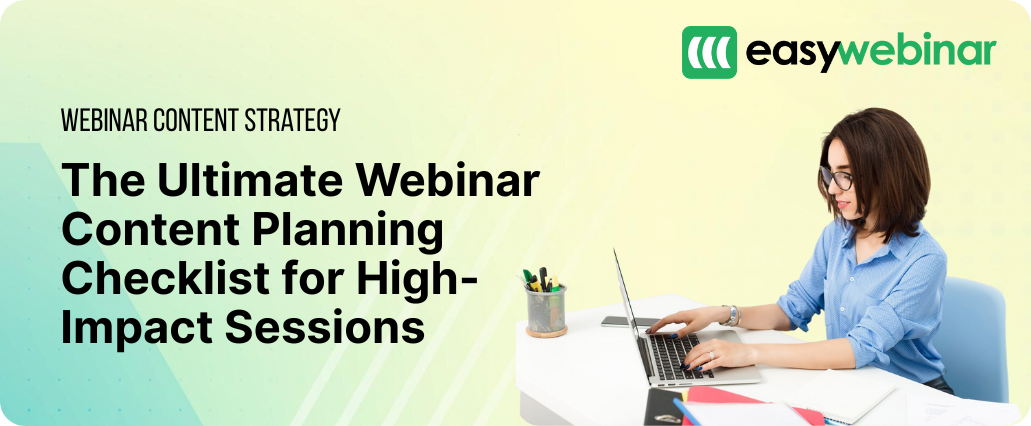Webinar Content Strategy: The Ultimate Webinar Content Planning Checklist for High-Impact Sessions

Summary :
A successful webinar requires more than great speakers—it needs a detailed content strategy built weeks in advance. This guide breaks down every essential step, from goal-setting and audience research to interactive content design and post-event follow-ups. You’ll learn how to align your webinar with business objectives, segment your audience effectively, choose the right format and platform, and maximize ROI using post-webinar strategies. With practical examples and EasyWebinar’s key capabilities—like live and automated sessions, built-in email automation, engagement tools, and analytics—you’ll be equipped to create sessions that not only attract viewers but convert them into long-term customers.
Table of Contents
- Start with a Strong Webinar Strategy
- Know Your Audience and Their Needs
- Design Engaging Webinar Content
- Choose the Right Platform and Tools
- Conclusion
- FAQs
Did you know your webinar content strategy needs 8 weeks of planning before the event?
Many businesses look at registration numbers as their only measure of webinar success. A truly successful webinar should build a pipeline, not just generate leads. Webinars can deliver much more value – they help generate leads, nurture prospects, speed up pipeline growth, and boost customer retention.
A complete webinar planning checklist helps you achieve these results. The checklist should cover everything from measurable KPIs to post-event engagement. Research shows the day you pick matters too – Tuesday works best, with Monday, Thursday, and Wednesday close behind.
People don’t show up to webinars because they feel they “should” – they come because they can’t risk missing out. They want direct access to experts, industry achievers, and influencers. Your webinar prep must create content so valuable that your audience feels they need to register and attend.
This piece walks you through the ultimate webinar content strategy checklist. You’ll find ways to plan, execute, and boost the results of your next webinar. We cover everything from clear goals to repurposing content after the event, showing you how to create webinars that drive real business outcomes.
Start with a Strong Webinar Strategy
Your webinar content strategy needs a resilient foundation that recognizes webinars’ strategic value in marketing and sales. Webinars stand apart from other content formats. They keep viewers engaged for almost an hour while providing valuable first-party data and insights.
Understand the role of webinars in your funnel
Webinars work effectively throughout your marketing funnel. Educational webinars that showcase intellectual influence and industry trends attract top-of-funnel audiences who are still researching. These awareness-stage webinars help you connect with leads who want to learn more without product pressure.
Prospects actively evaluating options need more personalized, useful information during the consideration stage. These sessions educate audiences while naturally introducing your solutions.
Your product’s unique advantages shine through conversion-stage webinars for prospects who know what they need. Well-executed conversion webinars can speed up the sales cycle by eliminating doubts.
Customer relationships grow stronger through post-sale webinars that create upsell opportunities and encourage continued business.
Arrange webinar goals with business objectives
Your webinars need specific, measurable goals that support a broader business strategy. Clear goals transform your webinar from a simple online event into a powerful business growth tool.
Your webinar goals should directly support company growth initiatives. This connection turns webinars from standalone events into key components of your overall strategy.
To name just one example, see how international expansion goals might lead to webinars targeting global audiences with customized content. Customer retention priorities could shape webinar objectives toward building stronger relationships through exclusive insights.
Clear objectives keep your team focused and shape every decision from topic selection to calls-to-action. Lead generation, audience education, brand awareness, and customer nurturing become achievable targets.
Use a webinar content marketing strategy
Strategic content maximizes webinar impact and extends value. Research your target audience’s pain points, challenges, and goals. This knowledge shapes topics and content angles that match audience interests.
B2B event promotion should start four weeks ahead to help attendees save the date and boost live attendance. High-profile events with prestigious speakers might need earlier promotion to meet marketing goals.
Smart marketers avoid the common “one-and-done” webinar approach. They turn each webinar into a strategic asset by:
- Creating on-demand versions that enable viewers to watch content on their schedule
- Using registration and participation data to personalize future interactions
- Turning webinar content into blogs, e-books, and social media snippets
- Creating personalized landing pages based on participant interests and engagement data
This detailed approach transforms single webinars into self-guided buying experiences that prospects enjoy while giving your organization insights to advance your pipeline.
This strategic approach to webinar planning and execution creates measurable results that match your broader business goals.

Know Your Audience and Their Needs
Your webinar content strategy’s success depends on knowing how to understand your audience and their needs. Research shows webinar surveys can increase attendance likelihood by 60%. This makes audience research a vital step in your webinar preparation checklist.
Segment your audience by role and intent
Smart audience segmentation turns basic webinar content into targeted, high-impact sessions. You should start by grouping potential attendees based on their professional roles, challenges, and their position in the buyer’s trip.
Companies using well-researched audience personas generate 24% more high-quality leads. This shows how valuable detailed segmentation can be. Here are the key segments to think about:
- By professional role: Healthcare professionals seek clinical updates and practical applications, while marketing teams need campaign strategies and consumer insights
- By funnel position: New prospects need educational content, mid-stage audiences want detailed solutions, and late-stage viewers look for product demonstrations
- By intent: Find out if attendees want to solve specific problems, expand knowledge, or connect with industry leaders
Smart segmentation helps you customize your webinar planning checklist for each group and ensures content appeals to everyone at your session.
Conduct pre-webinar surveys
Pre-webinar surveys are a great way to get audience intelligence. They help you understand attendees’ experience levels, expectations, and their device priorities before your event.
Your surveys should ask about:
- Prior knowledge of the webinar topic and expertise level
- Goals and expectations for attending
- Specific challenges they want to address
- Preferred content formats and ways to participate
- Technical setup and device information
This information helps you make smart decisions about content complexity, technical requirements, and engagement strategies. These questions also build excitement as participants see you’re creating an experience just for them.
Schedule your pre-webinar survey 1-2 weeks before the event. This gives you enough time to analyze responses and adjust your content to match your webinar content marketing strategy.
Tailor content to audience pain points
Understanding and addressing your audience’s pain points might be the most significant part of your webinar content strategy. Pain points are the specific problems your audience actively tries to solve – the challenges that worry them most.
Highlighting these issues makes your webinar more relevant right away. To name just one example, marketers often struggle with reaching engagement thresholds and proving ROI, while educators find it hard to keep students engaged in virtual classrooms.
You can find these pain points by:
- Looking through customer support tickets for common questions
- Checking how previous content performed to see what appeals
- Talking to sales and customer success teams
- Using LinkedIn polls to quickly understand audience interests
Structure your webinar content to tackle these challenges with practical solutions. Studies show 36% of B2B companies generate more qualified leads when they directly address buyer challenges.
Note that focusing on pain points does more than improve attendance. It turns your webinar from a presentation into a valuable resource that solves ground problems, which increases engagement and conversion rates.
Understanding your audience through segmentation, surveys, and pain point identification helps you create webinar content that speaks directly to attendees’ needs. This positions your sessions as must-attend events rather than optional presentations.

Design Engaging Webinar Content
Your webinar content strategy starts with creating content that captures attention. Research shows people’s focus drops after just 8 minutes. This makes it essential to design content that keeps your audience hooked throughout the presentation.
Choose the right format: panel, AMA, demo, etc.
The webinar format you pick can make a big difference in how well your audience stays involved. Here are some proven formats based on what you want to achieve:
- Panel discussions: These work great for industry events where multiple experts share their viewpoints on complex topics. The format shines when topics have different opinions and new breakthroughs.
- Q&A/AMA sessions: These help address your audience’s main concerns head-on. You can build trust and establish credibility by answering questions openly.
- Product demos: Software and tech companies find these valuable to show their solutions in action. Potential customers get to see products work firsthand.
- Training webinars: These help deliver educational content and let participants develop specific skills through well-laid-out learning experiences.
Your topic’s complexity and your audience’s priorities should guide your choice. Complex subjects work better as workshops that focus on hands-on learning. Panel discussions excel with controversial topics.
Create a content outline and flow
A well-laid-out webinar outline acts as your guide to keep the presentation on track and engaging. Picture your webinar as an exciting book with you as the hero, audience challenges as the villain, and your insights as the path to success.
Your outline needs valuable information spread throughout the presentation. Attendees quickly lose interest without steady value delivery. Break content into bite-sized chunks and focus on answering viewer questions instead of talking non-stop.
Most webinars work best between 45-60 minutes. Add a 10-20 minute Q&A session at the end – a technique 81% of marketers employ. This setup helps deliver complete information while keeping the audience focused.
Incorporate storytelling and real examples
Stories turn ordinary webinars into unforgettable experiences. Our brains naturally connect with narratives better than plain facts. So, storytelling could double how effective your webinar becomes.
Start by showing the gap between current problems and possible solutions. This grabs attention and makes your content feel more relevant. Ground examples help show how your information works in practice.
Lead with a powerful story that shows the problem instead of jumping straight to statistics. Present case studies like detective stories that walk attendees through each discovery step.
Add interactive elements to boost engagement
Interactive features turn passive viewers into active participants. Webinars with interactive elements see 33% better attendee retention and 22% longer viewing times.
These interactive elements work particularly well:
- Polls and surveys: They get people involved right away and help you learn about your attendees.
- Live Q&A: Let people ask questions during your presentation. Mention their names when answering to create personal connections.
- Breakout rooms: Small discussion groups help people work hands-on and solve problems right away.
- Quizzes: They add fun competition while reinforcing key points and checking understanding.
These strategic elements will help your webinar not just inform but truly connect with your audience from start to finish.

Choose the Right Platform and Tools
Your webinar content strategy works only as well as the platform you pick to deliver it. The right webinar software plays a vital role in executing your planned content and getting the most attendee involvement.
Compare webinar platforms
Several key factors help determine which platform will support your webinar content marketing strategy best:
- Audience capacity: The main difference between simple video conferencing tools and dedicated webinar platforms lies in attendance capacity. Some platforms can handle 100-250 participants. Others support thousands of users. Your predicted audience size becomes a key factor to think over.
- Feature set: Each platform gives you different ways to deliver your webinar. Think about whether you need breakout rooms, polls, Q&A features, or automated emails based on your content plan.
- Integration capabilities: Your webinar platform should connect with your marketing tools to work well. Look for platforms that combine smoothly with your CRM, email marketing systems, or calendar apps to make your webinar preparation easier.
- Pricing structure: Webinar platforms vary a lot in cost, and many charge based on attendee numbers. Compare prices based on your typical audience size and needed features to find a budget-friendly option for your webinar strategy.
- User experience: The platform should be easy to use for hosts and attendees alike. Technical problems can ruin even well-planned webinars. Pick platforms with easy-to-use interfaces.
Why EasyWebinar is a Top Choice
EasyWebinar is a reliable platform for running both live and automated webinars. It provides a comprehensive set of tools to support your webinar content strategy:
Flexible Webinar Options
EasyWebinar supports live and automated sessions, allowing you to schedule webinars for your audience.
Built-in Email Automation
Manage pre-event notices, day-of reminders, and post-webinar follow-ups directly within EasyWebinar, without needing additional email tools.
Interactive Engagement Tools
Engage participants with live polls, chat, offers and Q&A features. These tools help maintain attention and gather feedback during your webinar.
Advanced Analytics
The dashboard tracks attendance, engagement time, poll responses, and drop-offs. Use these insights to refine future webinars.
Mobile and Browser Compatibility
EasyWebinar works across modern browsers like Chrome, Firefox, Safari, and Edge, allowing attendees to join directly without installing additional software.
Email Sequences and Follow-Ups
Automate webinar-related emails directly in the platform. Use pre-event, day-of, and post-event sequences to engage participants. With smart scheduling you can set the timezone (streams in your viewer’s local timezone) and frequency. Add polls, offers, and create custom web pages.
Integrations
EasyWebinar connects with leading email marketing platforms, such as ActiveCampaign, GetResponse, Drip, and Mailchimp, for automated behavior-triggered follow-ups.
Illustrative Strategies (Not Platform-Specific)
- Personalized CTAs and landing pages can improve conversions.
- Repurposing webinar content into blogs, videos, or guides can expand your reach.
- Influencer promotion may help increase registrations.
Conclusion
Good webinars need solid planning and smart execution at each step. A winning webinar strategy takes more than just showing up to present—you just need careful preparation on many fronts.
Your webinar strategy should line up with your business goals, whether you want to generate leads, educate prospects, or keep existing customers. Webinars work at different stages of your marketing funnel. Your content should match these goals and what your audience wants.
Understanding your audience is vital to make your webinar work. Good segmentation, pre-event surveys, and knowing pain points help you create content that appeals to participants. This makes your sessions must-attend events rather than optional ones.
The right platform plays a big role in delivering smooth experiences. EasyWebinar gives you adaptable options with dynamic scheduling, built-in email automation, and advanced analytics. These features turn one-time events into ongoing value creators.
Your work doesn’t stop when your webinar ends. The post-event phase gives you great chances to extend your content’s life through smart follow-up, content reuse, and data review.
Webinars are powerful tools that connect you with audiences while collecting valuable first-party data. With proper planning, they give you real business results that go beyond registration numbers.
A winning webinar needs a detailed strategy from original planning through post-event follow-up. By doing this and being organized with platforms like EasyWebinar, you can create engaging webinar experiences. Your audience will look forward to attending these sessions that deliver real business results.
FAQs
Q1. How far in advance should I start planning my webinar?
It’s recommended to begin planning your webinar about 8 weeks before the event date. This allows ample time for content creation, promotion, and technical preparations.
Q2. What’s the ideal length for a webinar?
The optimal duration for a webinar is typically 45-60 minutes, including a 10-20 minute Q&A session at the end. This length allows for comprehensive information delivery while maintaining audience attention.
Q3. How can I make my webinar more engaging?
To boost engagement, incorporate interactive elements such as polls, live Q&A sessions, and breakout rooms. Also, use storytelling techniques and real-world examples to make your content more relatable and memorable.
Q4. What’s the best day to host a webinar?
Studies suggest that Tuesday is the most effective day for hosting webinars, followed by Monday, Thursday, and Wednesday. However, consider your specific audience’s preferences when scheduling.
Q5. How can I maximize the value of my webinar after it’s over?
After your webinar, send follow-up emails with replay links, repurpose the content into various formats like blog posts and social media clips, analyze performance metrics, and gather feedback to improve future sessions. This extends the lifespan of your content and increases its overall impact.